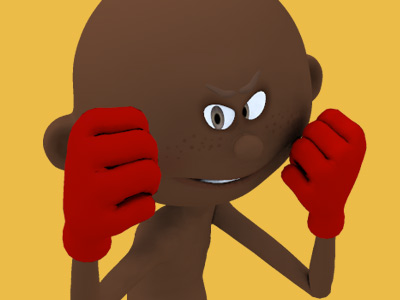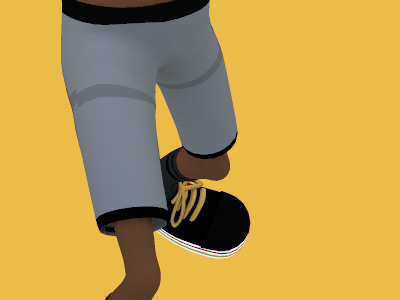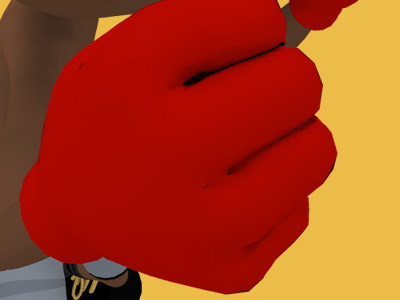Boxing
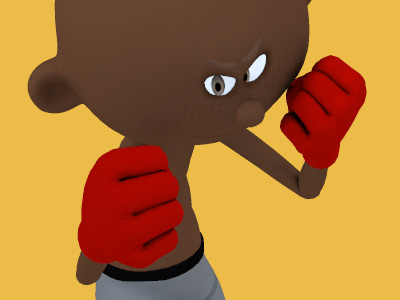
Boxing Punches
There are four basic punches in boxing: the jab, cross, hook and uppercut. Any punch other than a jab is considered a power punch. If a boxer is right-handed (orthodox), his left hand is the lead hand and his right hand is the rear hand. For a left-handed boxer or southpaw, the hand positions are reversed. For clarity, the following discussion will assume a right-handed boxer.
- Jab – A quick, straight punch thrown with the lead hand from the guard position. The jab is accompanied by a small, clockwise rotation of the torso and hips, while the fist rotates 90 degrees, becoming horizontal upon impact. As the punch reaches full extension, the lead shoulder can be brought up to guard the chin. The rear hand remains next to the face to guard the jaw. After making contact with the target, the lead hand is retracted quickly to resume a guard position in front of the face.
- The jab is recognized as the most important punch in a boxer's arsenal because it provides a fair amount of its own cover and it leaves the least amount of space for a counter punch from the opponent. It has the longest reach of any punch and does not require commitment or large weight transfers. Due to its relatively weak power, the jab is often used as a tool to gauge distances, probe an opponent's defenses, harass an opponent, and set up heavier, more powerful punches. A half-step may be added, moving the entire body into the punch, for additional power. Some notable boxers who have been able to develop relative power in their jabs and use it to punish or 'wear down' their opponents to some effect include Larry Holmes and Wladimir Klitschko.
- Cross – A powerful, straight punch thrown with the rear hand. From the guard position, the rear hand is thrown from the chin, crossing the body and traveling towards the target in a straight line. The rear shoulder is thrust forward and finishes just touching the outside of the chin. At the same time, the lead hand is retracted and tucked against the face to protect the inside of the chin. For additional power, the torso and hips are rotated counter-clockwise as the cross is thrown. A measure of an ideally extended cross is that the shoulder of the striking arm, the knee of the front leg and the ball of the front foot are on the same vertical plane.
- Weight is also transferred from the rear foot to the lead foot, resulting in the rear heel turning outwards as it acts as a fulcrum for the transfer of weight. Body rotation and the sudden weight transfer is what gives the cross its power. Like the jab, a half-step forward may be added. After the cross is thrown, the hand is retracted quickly and the guard position resumed. It can be used to counter punch a jab, aiming for the opponent's head (or a counter to a cross aimed at the body) or to set up a hook. The cross is also called a "straight" or "right", especially if it does not cross the opponent's outstretched jab.
- Hook – A semi-circular punch thrown with the lead hand to the side of the opponent's head. From the guard position, the elbow is drawn back with a horizontal fist (knuckles pointing forward) and the elbow bent. The rear hand is tucked firmly against the jaw to protect the chin. The torso and hips are rotated clockwise, propelling the fist through a tight, clockwise arc across the front of the body and connecting with the target.
- At the same time, the lead foot pivots clockwise, turning the left heel outwards. Upon contact, the hook's circular path ends abruptly and the lead hand is pulled quickly back into the guard position. A hook may also target the lower body and this technique is sometimes called the "rip" to distinguish it from the conventional hook to the head. The hook may also be thrown with the rear hand. Notable left hookers include Joe Frazier, Roy Jones Jr. and Mike Tyson.
- Uppercut – A vertical, rising punch thrown with the rear hand. From the guard position, the torso shifts slightly to the right, the rear hand drops below the level of the opponent's chest and the knees are bent slightly. From this position, the rear hand is thrust upwards in a rising arc towards the opponent's chin or torso.
- At the same time, the knees push upwards quickly and the torso and hips rotate anti-clockwise and the rear heel turns outward, mimicking the body movement of the cross. The strategic utility of the uppercut depends on its ability to "lift" the opponent's body, setting it off-balance for successive attacks. The right uppercut followed by a left hook is a deadly combination employing the uppercut to lift the opponent's chin into a vulnerable position, then the hook to knock the opponent out.
These different punch types can be thrown in rapid succession to form combinations or "combos." The most common is the jab and cross combination, nicknamed the "one-two combo." This is usually an effective combination, because the jab blocks the opponent's view of the cross, making it easier to land cleanly and forcefully.
A large, swinging circular punch starting from a cocked-back position with the arm at a longer extension than the hook and all of the fighter's weight behind it is sometimes referred to as a "roundhouse," "haymaker," "overhand," or sucker-punch. Relying on body weight and centripetal force within a wide arc, the roundhouse can be a powerful blow, but it is often a wild and uncontrolled punch that leaves the fighter delivering it off balance and with an open guard.
Wide, looping punches have the further disadvantage of taking more time to deliver, giving the opponent ample warning to react and counter. For this reason, the haymaker or roundhouse is not a conventional punch, and is regarded by trainers as a mark of poor technique or desperation. Sometimes it has been used, because of its immense potential power, to finish off an already staggering opponent who seems unable or unlikely to take advantage of the poor position it leaves the puncher in.
Another unconventional punch is the rarely used bolo punch, in which the opponent swings an arm out several times in a wide arc, usually as a distraction, before delivering with either that or the other arm.
An illegal punch to the back of the head or neck is known as a rabbit punch.
It should be noted both the hook and uppercut may be thrown with both hands, resulting in differing footwork and positioning from that described above if thrown by the other hand. Generally the analogous opposite is true of the footwork and torso movement.
SPORTS
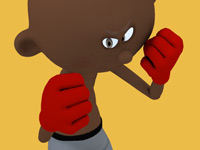
RESOURCES
This article uses material from the Wikipedia articles "Boxing" and "Marquess of Queensberry Rules" which is released under the Creative Commons Attribution-Share-Alike License 3.0.
© Stories Preschool. All Rights Reserved.
